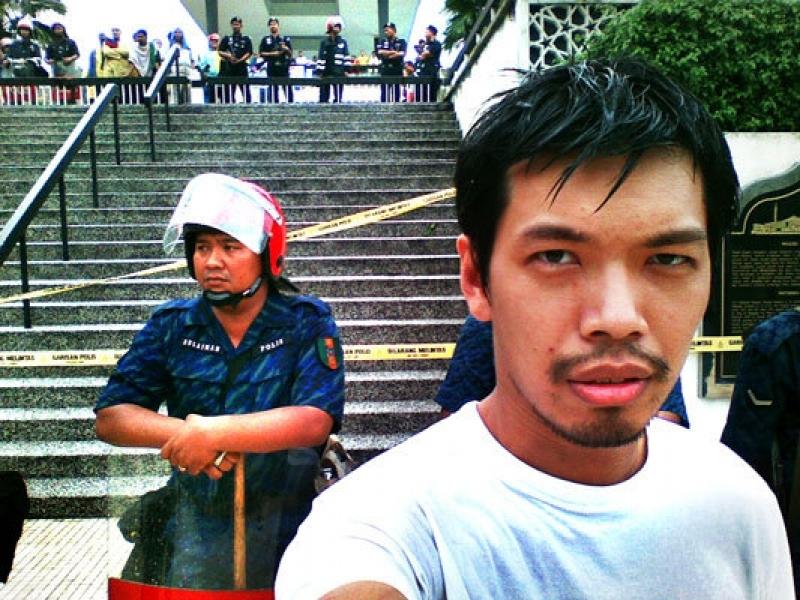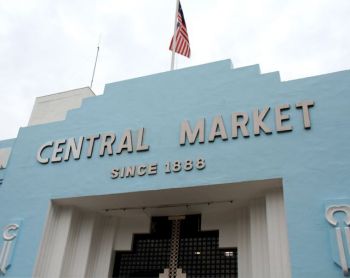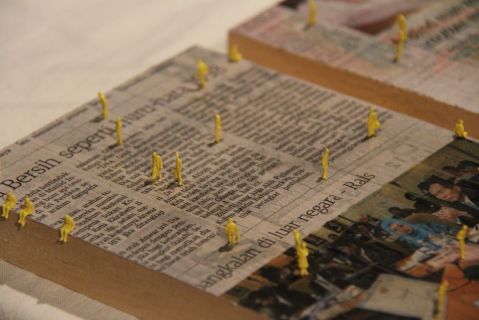theartsdesk in Kuala Lumpur: Culture as a Weapon | reviews, news & interviews
theartsdesk in Kuala Lumpur: Culture as a Weapon
theartsdesk in Kuala Lumpur: Culture as a Weapon
The arts take on the oppressive weight of the Malaysian state

As hot, sweaty tourists dangle their feet in pools for Thai Nibble Fish to eat the dead skin from their feet at Kuala Lumpur’s quirky Art Deco Central Market, a small theatre upstairs is packed for a play about racial divisions and the myth of social unity here.
The Annexe Gallery is a brave and daring space where art meets dissidence in a country whose media is intimidated, where there is no freedom of speech and the draconian Internal Security Act and media laws are used to crush dissenting voices and justify arbitrary arrests. Audiences are often swelled by plain-clothes police and gallery director Pang Khee Teik, also an outspoken gay activist, receives frequent “friendly” calls from security authorities “to see how things are going”.
Although much of the media is muzzled, corrupt or inept, the Malaysian blogosphere is robust – if constantly censured and threatened by a government under strain. But the Annexe Gallery offers a more tactile and immediate form of political engagement. So far, the Gallery has been able to get away with actions many in this police state would expect to land them in jail. “The work we do is dangerous. Because we inflame people,” says 36-year-old Pang, enthusiastic and irrepressible as he downs a bowl of noodles and a cold beer in the humid air outside the market’s Rainforest Café before the first performance here of Parah.
 In the iconic Central Market it is flanked on the one side by restored baba-nyonya shophouses – the same style many tourists will have seen in Singapore’s Chinatown - and the fast-running, milk-coffee-brown Klang River on the other. It lies at the cultural, geographic and historic heart of the city founded by Chinese immigrant Yap Ah Loy. It was originally a typically chaotic pasar basah (wet market) in what was then the heart of a new city built on tin, rubber and commerce in the 19th century under British colonial rule. As the city grew, so did the Yap Ah Loy market. The traditional jumble of bamboo and palm-thatched stalls was replaced by a permanent building with concrete tiled floors, timber-clad walls and a roof covered with zinc sheeting. This was upgraded in the mid-1930s to the Art Deco design of Malaysian architect TY Lee that forms the basis of the current complex. For years, the Market was Kuala Lumpur's largest single room, at over 120 metres long and half the width.
In the iconic Central Market it is flanked on the one side by restored baba-nyonya shophouses – the same style many tourists will have seen in Singapore’s Chinatown - and the fast-running, milk-coffee-brown Klang River on the other. It lies at the cultural, geographic and historic heart of the city founded by Chinese immigrant Yap Ah Loy. It was originally a typically chaotic pasar basah (wet market) in what was then the heart of a new city built on tin, rubber and commerce in the 19th century under British colonial rule. As the city grew, so did the Yap Ah Loy market. The traditional jumble of bamboo and palm-thatched stalls was replaced by a permanent building with concrete tiled floors, timber-clad walls and a roof covered with zinc sheeting. This was upgraded in the mid-1930s to the Art Deco design of Malaysian architect TY Lee that forms the basis of the current complex. For years, the Market was Kuala Lumpur's largest single room, at over 120 metres long and half the width.
After the market was saved from demolition at the last minute during the largely uncontrolled building boom of the 1970s, it was declared a heritage site and in the mid-1990s renowned Asian architect William Lim was hired to design the latest upgrade.
It has an impressive entrance of Middle Eastern-inspired steps, interlocking iron, with a frieze just below the roof, while the windows and skylights are made of calorex, limiting the heat of the sun from coming in, but maximising light. The ceilings are high – eight metres - and the light soft. Internally, it recreates the traditional intimate smell and feel of small pasar stalls, although the building is air-conditioned and much of it is now divided into different ethnic lanes – officially to celebrate diversity, but which in fact accentuates the increasing contrasts.
Once every three months, the Annexe holds a flea market with a difference. Dioramas outlining plans for a major anti-government rally share space in the timber-floored halls with the Sisters of Islam and tables selling homemade jewels, coffee-table history books, knitting and black-and-white photos. The smell of incense and food wafting from the stalls below is intoxicating.
The Annexe also hosts discussions and exhibitions on such a diverse range of subjects as the rebellion in mainly Muslim southern Thailand and student activism in Iran. And it played a major role in rallying support for the recent Bersih (Clean) protest against the Government that began outside these doors and which saw non-violent protestors tear-gassed, hit with chemical water cannon and beaten after they were arrested. (Pictured below: a piece of art representing a protest against restrictions on public gatherings)

Pang, who for years had an internal battle between his strong Christian faith and his homosexuality, says the Government of Prime Minister Najib Razak has co-opted and rewritten Malaysia’s cultural narrative as a political tool, following the tactics of former prime minister Mahathir Mohamad. Their United Malays National Organisation (UMNO) and its Barisan Nasional (National Front) coalition has ruled without a serious challenge since independence in 1957, until a major electoral setback that almost ousted them in 2008.
“The state uses culture as a weapon,” Pang says. “We are using culture to empower the people. One of the roles of the arts is to voice the conscience of the people. One of the roles of the arts is to be critical.
Pang cites the centuries-old tradition of Wayang Kulit (shadow puppets) in Malaysia and Indonesia where the dalang (puppetmaster) often cheekily ad-libs to mock local royalty and village headmen. And he also points to the lack of quality political satire in Malaysia, such as the lyrical poetry of Indonesia’s immensely popular veteran singer Iwan Fals, who managed to mock the Suharto regime yet avoid arrest. “We have no one like Iwan Fals here,” he says. “We have no one singing about reformasi. I must admit, I am a bit pessimistic. I sometimes think we are at the beginning of the dark ages here in Malaysia.”
Mahathir, who crushed all dissent in his undisputed rule from 1981 to 2003, is blamed by critics for rewriting the cultural narrative of a multi-ethnic country in order to promote the bumiputra – sons of the soil, or Malays. His defenders say he has woven a more accurate and cohesive story of the history of this diverse nation that stretches from Thailand down the Malay peninsula and on to Borneo in the Far East and helped advance the Malays, who were at the lowest levels when the British handed over in 1957.
But at the Annexe Gallery, all views are open for discussion and interpretation. Plays are routinely followed by Q&As with the cast, director and playwright. “It’s never just a performance,” says Parah director Jo Kukathas after opening night. “We tell a story. It’s also our way of declaring these things (issues).” Pang and other critics say more than five decades of UMNO rule and thought control have ruined a once rich and diverse country - one that has gone backwards since independence. They point to the economic success and racial harmony of neighbouring Singapore - the basket case
of the Malay Federation when it was expelled in 1965 - and which have eluded UMNO's Malaysia. “I am ready to go to jail for what I believe in," says Pang. "They are basically just creating drones and factory workers. I think they have fucked us over.”
The future of Arts Journalism
You can stop theartsdesk.com closing!
We urgently need financing to survive. Our fundraising drive has thus far raised £49,000 but we need to reach £100,000 or we will be forced to close. Please contribute here: https://gofund.me/c3f6033d
And if you can forward this information to anyone who might assist, we’d be grateful.

Subscribe to theartsdesk.com
Thank you for continuing to read our work on theartsdesk.com. For unlimited access to every article in its entirety, including our archive of more than 15,000 pieces, we're asking for £5 per month or £40 per year. We feel it's a very good deal, and hope you do too.
To take a subscription now simply click here.
And if you're looking for that extra gift for a friend or family member, why not treat them to a theartsdesk.com gift subscription?

Add comment